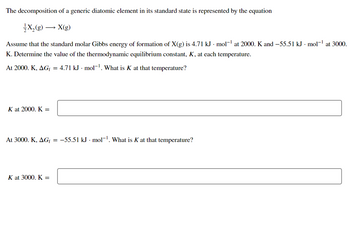
Chemistry
10th Edition
ISBN: 9781305957404
Author: Steven S. Zumdahl, Susan A. Zumdahl, Donald J. DeCoste
Publisher: Cengage Learning
expand_more
expand_more
format_list_bulleted
Question

Transcribed Image Text:The decomposition of a generic diatomic element in its standard state is represented by the equation
X₂(g) → X(g)
Assume that the standard molar Gibbs energy of formation of X(g) is 4.71 kJ - mol-¹ at 2000. K and −55.51 kJ · mol-¹ at 3000.
K. Determine the value of the thermodynamic equilibrium constant, K, at each temperature.
At 2000. K, AG₁ = 4.71 kJ · mol-¹. What is K at that temperature?
K at 2000. K=
At 3000. K, AGf = −55.51 kJ - mol-¹. What is K at that temperature?
K at 3000. K =
Expert Solution
This question has been solved!
Explore an expertly crafted, step-by-step solution for a thorough understanding of key concepts.
Step by stepSolved in 4 steps with 2 images

Knowledge Booster
Learn more about
Need a deep-dive on the concept behind this application? Look no further. Learn more about this topic, chemistry and related others by exploring similar questions and additional content below.Similar questions
- dont provide handwriting solution .....arrow_forwardFor a certain chemical reaction, the standard Gibbs free energy of reaction at 5.00 °C is 142. kJ. Calculate the equilibrium constant K for this reaction. Round your answer to 2 significant digits. K = ||arrow_forwardA 65.0 g piece of gold at 650 K is dropped into 162 g of H2O(l) at 298 K in an insulated container at 1 bar pressure. CP,m for Au and H2O at 298 K are 25.4 and 75.3 J⋅K−1⋅mol−1, respectively. Calculate the temperature of the system once equilibrium has been reached. Assume that CP,m for Au and H2O are constant at their values for 298 K throughout the temperature range of interest.arrow_forward
- When temperature increases from – 15.0 °C to + 15.0 °C, the thermodynamic equilibrium constant for the reaction increases four times. Calculate the standard enthalpy for the reaction.arrow_forwardFor a certain chemical reaction, the standard Gibbs free energy of reaction is -107. kJ. Calculate the temperature at which the equilibrium constant K = 1.2 × 1020 Round your answer to the nearest degree. T = 0 °Carrow_forwardFor a certain reaction, ΔHº = −1.8 x 102 kJ mol−1 and the equilibrium constant at 800. K is 9.1 × 102 . Estimate the temperature at which the equilibrium constant is 1.0 × 106 .arrow_forward
- Determine the equilibrium vapor pressure of germanium metal at 326.0 °C. The standard enthalpy of vaporization of germanium is 376.6 kJ/mol and the vapor pressure at 100.0 °C is 1.6E-32 Pa.arrow_forwardhe decomposition of a generic diatomic element in its standard state is represented by the equation 12X2(g)⟶X(g) Assume that the standard molar Gibbs energy of formation of X(g) is 4.20 kJ·mol−1 at 2000. K and −53.38 kJ·mol−1 at 3000. K. Determine the value of the thermodynamic equilibrium constant, ?, at each temperature. At 2000. K, Δ?f=4.20 kJ·mol−1. What is ? at that temperature? ? at 2000. K= At 3000. K, Δ?f=−53.38 kJ·mol−1. What is K at that temperature? ? at 3000. K=arrow_forwardFor a gaseous reaction, standard conditions are 298 K and a partial pressure of 1 atm for all species. For the reaction N, (g) + 3 H, (g) = 2 NH,(g) the standard change in Gibbs free energy is AG° = –72.6 kJ/mol. What is AG for this reaction at 298 K when the partial pressures are PN, = 0.500 atm, PH, = 0.500 atm, and PNH, = 0.600 atm? AG = kJ/molarrow_forward
- For a certain chemical reaction, the equilibrium constant K = ×7.7106 at 5.00 °C . Calculate the standard Gibbs free energy of reaction.Round your answer to 2 significant digits.arrow_forwardFor a certain chemical reaction, the equilibrium constant K = 2.8 × 104 at 5.00 °C. Calculate the standard Gibbs free energy of reaction. Round your answer to 2 significant digits. AG° = kJ x10 X Śarrow_forwardFor a certain chemical reaction, the standard Gibbs free energy of reaction is - 149. kJ. Calculate the temperature at which the equilibrium constant K = 1.3 × 1026. Round your answer to the nearest degree. T=arrow_forward
arrow_back_ios
arrow_forward_ios
Recommended textbooks for you
 ChemistryChemistryISBN:9781305957404Author:Steven S. Zumdahl, Susan A. Zumdahl, Donald J. DeCostePublisher:Cengage Learning
ChemistryChemistryISBN:9781305957404Author:Steven S. Zumdahl, Susan A. Zumdahl, Donald J. DeCostePublisher:Cengage Learning ChemistryChemistryISBN:9781259911156Author:Raymond Chang Dr., Jason Overby ProfessorPublisher:McGraw-Hill Education
ChemistryChemistryISBN:9781259911156Author:Raymond Chang Dr., Jason Overby ProfessorPublisher:McGraw-Hill Education Principles of Instrumental AnalysisChemistryISBN:9781305577213Author:Douglas A. Skoog, F. James Holler, Stanley R. CrouchPublisher:Cengage Learning
Principles of Instrumental AnalysisChemistryISBN:9781305577213Author:Douglas A. Skoog, F. James Holler, Stanley R. CrouchPublisher:Cengage Learning Organic ChemistryChemistryISBN:9780078021558Author:Janice Gorzynski Smith Dr.Publisher:McGraw-Hill Education
Organic ChemistryChemistryISBN:9780078021558Author:Janice Gorzynski Smith Dr.Publisher:McGraw-Hill Education Chemistry: Principles and ReactionsChemistryISBN:9781305079373Author:William L. Masterton, Cecile N. HurleyPublisher:Cengage Learning
Chemistry: Principles and ReactionsChemistryISBN:9781305079373Author:William L. Masterton, Cecile N. HurleyPublisher:Cengage Learning Elementary Principles of Chemical Processes, Bind...ChemistryISBN:9781118431221Author:Richard M. Felder, Ronald W. Rousseau, Lisa G. BullardPublisher:WILEY
Elementary Principles of Chemical Processes, Bind...ChemistryISBN:9781118431221Author:Richard M. Felder, Ronald W. Rousseau, Lisa G. BullardPublisher:WILEY

Chemistry
Chemistry
ISBN:9781305957404
Author:Steven S. Zumdahl, Susan A. Zumdahl, Donald J. DeCoste
Publisher:Cengage Learning

Chemistry
Chemistry
ISBN:9781259911156
Author:Raymond Chang Dr., Jason Overby Professor
Publisher:McGraw-Hill Education

Principles of Instrumental Analysis
Chemistry
ISBN:9781305577213
Author:Douglas A. Skoog, F. James Holler, Stanley R. Crouch
Publisher:Cengage Learning

Organic Chemistry
Chemistry
ISBN:9780078021558
Author:Janice Gorzynski Smith Dr.
Publisher:McGraw-Hill Education

Chemistry: Principles and Reactions
Chemistry
ISBN:9781305079373
Author:William L. Masterton, Cecile N. Hurley
Publisher:Cengage Learning

Elementary Principles of Chemical Processes, Bind...
Chemistry
ISBN:9781118431221
Author:Richard M. Felder, Ronald W. Rousseau, Lisa G. Bullard
Publisher:WILEY